
|   |

|   |
 e-mail: leelakaverivenkat@gmail.com Laudable attempts at recapturing flavours of Vedic women and their wisdom Photos courtesy: Koochipoodi Dance Centre September 3, 2023 Supported by the Ministry of Culture, as part of Azadi ka Amrit Mahotsav celebrations, the Koochipoodi Dance Centre of Swapnasundari presented Brahmavadini-Vedic Women of Wisdom at the C.S.O.I auditorium, Delhi, in what must be regarded as one of the rarest of programs. Researched, visualized and directed by Swapnasundari, the performances over two successive evenings, brought glimpses of six Brahmavadinis of the Vedic period - Maitreyi, Ghosha, Romasha, Lopamudra, Apala and Gargi - by reputed dancers each representing a different tradition of dance, covering in the process six dance forms. Suman Sanjay Agarwal, the compere, in her succinct introduction summed up the state of women in the Vedic era. Equal to the sons in every way, daughters too went through the coming of age upanayanam (thread ceremony), and had full authority for reading the Sastras and participating in Vedic rituals. Women were allowed to partake of soma rasa and considered Dharma Rakshaks along with men - to the extent of participating in battles as soldiers - thus sharing in every activity man was part of. If anything, woman's position in our society today would seem to suggest regression rather than progress. 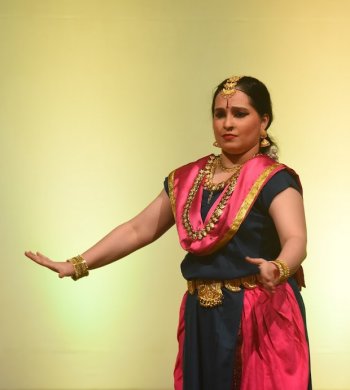 Malavika Arora The presentation began with the entrance of the Natee, in the person of Malavika Arora, a student of Swapnasundari, in a passage devised and choreographed by Swapnasundari in the Vilasini Natyam mode - researched and revived by Swapna so diligently. She recounted briefly the halcyon Rig Veda Age, where the Gods were pleased that women were respected, with both male and female in the role of Sastra/Karma Rakshakas. Naming the Satyavahinis and Madhurabhashinis to be introduced to the audience, the Natee concludes, "Let us see from those days to today - what woman has lost and what she has gained (Nari ne kya khoya, kya paya?)". In a simple costume with no frills, catching a sense of the kind of women's getup reflected in ancient sculptural representations, this twinkle-eyed, light-footed dancer ushered a breezy start to the proceedings. 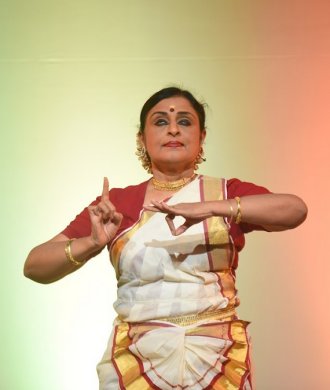 Deepti Omchery Bhalla The first Brahmavadini to be appear before the audience was Maitreyi, represented by Mohiniattam dancer/scholar Deepti Omchery Bhalla. Estimated to have lived around 8th century BCE, this second wife of sage Yagnavalkya, as mentioned in the Brihadaranyaka Upanishad, was the daughter of sage Maitri, who lived in the Videha kingdom of King Janaka - and according to some accounts, as a minister. In the Mahabharata and Grhyasutras, one Sulabha Maitreyi is represented differently as a beautiful and unmarried Advaita philosopher. Deciding to embark on vanaprashta by embracing sainthood, Yagnavalkya plans to take leave of his wives after dividing his property equally between them. Katyayini being content in domesticity, Maitreyi's self-questioning, restless mind constantly reflects on trying to understand the nature of metaphysical life - the Atman, Brahman and Para Brahman. The Brihadaranyaka Upanishad has the potent question and answer dialogue between Maitreyi and her husband (where she constantly challenges him) forming the crux of Advaita philosophy - on whether possessions and relationships can constitute happiness - which ultimately is a state of mind. Different European scholars too have rated this exchange as delineating the crux of Advaita and of understanding the nature of the Self. Surviving manuscript recensions of Madhyamadi and Kanva Vedic schools, despite literary differences, are mentioned as sharing the same philosophy. Dealing with the inner state of the mind, and beyond dance visualization through bold rhythm or movement, this dialogue calls for quietude and an evoked state-of-being, deeply internalized. While a graceful form of dance like Mohiniattam is ideally suited for this kind of quiet representation, Deepti's presentation actually flowed out of deep understanding and her pure abhinaya approach, proved immensely successful in holding the audience, without having to resort to the razzmatazz of loud rhythm. With a few deft touches, the off-white costume of Mohiniattam suggested the feel of otherness - of the Rig Vedic woman. And the music, which sounded made for the occasion, with an assemblage of bits of earlier recordings, one came to know later, provided the right support. 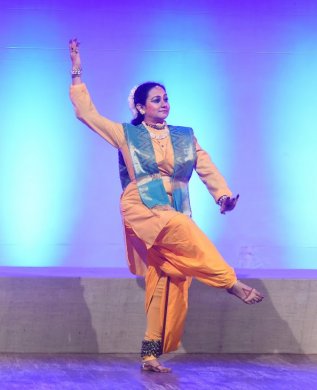 Moumala Nayak The next appearance in Kathak style by Moumala Nayak was on Ghosha, daughter of Rishi Kakshivat, disciple of Angiras and granddaughter of Dirgatamas - both persons credited with having composed Rig Vedic hymns. Stricken with a skin ailment from birth, unable to marry, Ghosha decided to enhance her knowledge by serving and praying to Ashvini Kumars, the divine twin physicians endowed with the powers to rejuvenate. They taught Ghosha the secret of Madhu Vidya which apart from curing her granted her eternal youth and knowledge. Credited with composing the Vedic hymns 9 and 49 of Mandal ten in the form of Suktas, each containing 14 verses of eulogies to Ashvini Devtas, expressing her intimate desire for married life, what stands out is Ghosha's strength of mind, without getting bogged by societal opinions about her as a woman. She is believed to have had her wish, with son Suhasya also composing a Rig Vedic hymn. Moumala is not one of those prolific performers - and trying to express how Gosha triumphs over self-pity and regains self-respect with confidence in her femininity, through the Kathak form, which rarely takes to such themes from India's Vedic past, must have been a unique experience. The dancer's unusual presentational composure comprised conviction with dignity - the message of desire for love and marriage and recognition of her femininity conveyed in a very understated, muted fashion. 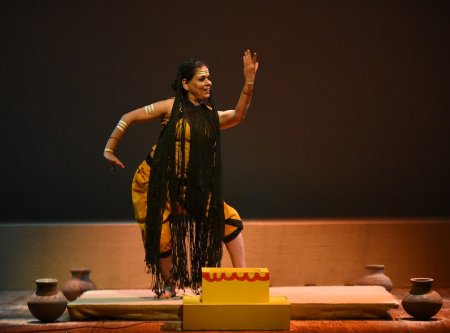 Sangeeta Sharma Women representing ancient India, being expressed through the language of Modern Dance, may seem like putting two opposites in time, together. But very convincingly did dancer Sangeeta Sharma, a long standing student of late Narendra Sharma, explore the character of Romasha's deep spirituality, as a Mantra-Drashta, with deep knowledge of the Rig Veda, and great ability for interpreting and transmitting the profound teaching of the Vedas. This daughter of sage Brihaspati and wife of King Bhavayavya, empowered by her superior intellect and spiritual power, with long hair covering the entire body, refuses to allow herself to suffer from complexes about lacking maidenly assets. Boldly addressing her indifferent husband, she commands self-respect, her strength drawing on a great mind with its own power and attraction. Romasha presents herself presiding over a Yagna with her hair prominently visible, propitiating the five elements, which are part of her body too. This is what and who I am, she seems to challenge. And finally (not part of the presentation), the husband acknowledges. With nothing actually said, the dancer's movement vocabulary suggests that sense of woman's empowerment through mind, not dependent on physical attributes. 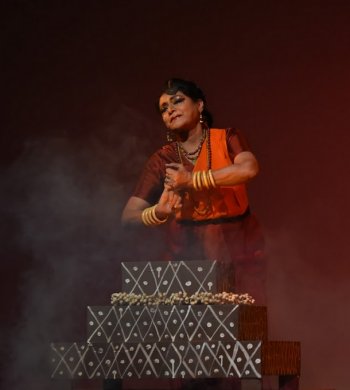 Swapnasundari Swapnasundari took upon herself the role of Lopamudra, so called because of the loss (lopa) suffered by various graceful parts of plants and animals, out of which sage Agastya fashioned her, before handing her over to the childless king of Vidarbha praying for an issue. Later, when Agastya himself asked for Lopamudra's hand in marriage, a reluctant king, persuaded by Lopamudra's consent, agreed to the match. Swapna's depiction centered round how, made to serve for years as the obedient wife of a sage bent on austerities, Lopamudra, over twenty years of selfless service, now aged and sans her youth and beauty, throwing aboard maidenly restraint, finally approaches her husband (hymn 179th of the Rig Veda) "pruviraham saradah sasramana / dosa vastotrusaso jayarati....." that labouring through many autumns, old age has diminished the beauty of the body. Reminding her husband that there is more to life than just asceticism, she draws attention to the togetherness of Kama, Artha and Dharma culminating in Moksha. The open expression of desire finally creates an impact and Lopamudra's marriage is consummated. Fully liberated, both Sage Agasthya and wife propagate Sri Vidya Upasana, upholding feminine creative energy Shakti expressed in the Lalita Sahasranamam. Apart from the portrayal of the exchange, the costume, with a high waisted choli and saree worn in tight 'kacha' fashion, added to the creating of an atmosphere. 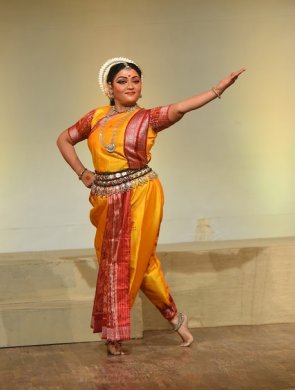 Kavita Dwibedi Explored in the Odissi mode by dancer Kavita Dwibedi, the Brahmavadini Apala, mentioned in the Satyayana Brahmana, figures in the 18th Mandala of the Rig Veda, wherein 7 mantras on Indra are attributed to her. Riddled by a skin ailment and abandoned by husband Krshasava, Apala is advised by father Sage Atri, to do penance to Indra, who when he appears is offered the juice of the Somalata plant Apala. Granted three boons by Indra, Apala, in a selfless fashion, first asks for her father to be cured of his baldness, and for his barren field to be made fertile, before asking for her own cure from the skin condition - all of which are agreed to. Yearning for beauty and a fulfilled marriage with motherhood, her determined effort at overcoming life's challenges, is what makes her story important. A sensitive dancer, her presentation built round the exchange with Indra, will, if one knows her, get further chiseled with new ideas. But what definitely needs some more thought is on the dancer's turnout, in a very tastefully draped costume with hair ornament tahira included, which was too much in the contemporary mode, and contrasted with the attempts of the other dancers in trying to emulate the look of woman during the Vedic period. 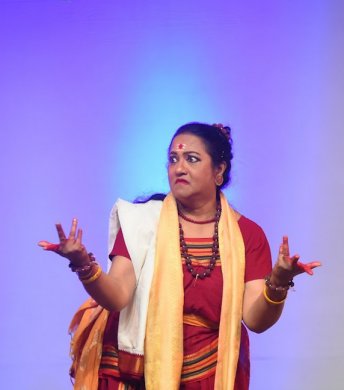 Kanaka Sudhakar In the Bharatanatyam style was Kanaka Sudhakar's presentation of Gargi, daughter of Sage Vachaknu in the Garga lineage, a reputed philosopher who, participating in the great debate organized by King Janaka of Videha (to which she was the only female Rishi invited), challenged Yagnavalkya himself (he who had mastered Kundalini Yoga) - something that even the male scholars were afraid of doing lest they be made to eat humble pie. Apart from the 6th to 8th Brahmana of Brihadaranyaka Upanishad, Gargi finds mention in Grihya Sutras of Asvalayana and is believed to have contributed to propagating education. In the Chandogya Upanishad too she is mentioned, questioning the origin of all existence. Kanaka Sudhakar, trained under Guru Shanta Dhananjayan, has no doubt all the abhinaya communication through hastas at her command. Capturing the Gargi/Yagnavalkya debate, moving from one side to the other to suggest the question and answer arguments, with all the proficiency of an experienced performer, the episode as presented could still be made less dry, one feels. Accompaniments could be utilized to make a difference. While the mridangam rhythm provided the backdrop throughout, perhaps some change in the rhythmic tone with ghatam on one side, would make for a less monochromatic sound pattern. Considering that this entire effort, supervised under Swapnasundari's efficient guidance, had been put together in just about two to three weeks, it was nothing short of amazing. With repeat shows over time, with fine tuning, as is bound to happen, this is a show which must travel to educational institutions and to varying audiences to spread an awareness about a period in our cultural heritage, about which little is known. A feather in the cap of Swapna for the ground work of research she is still engaged in! She is uncovering hitherto less explored areas, and from what one hears, she has done spade work on over fifty Brahmavadinis! More muscle to authentic work undertaken in this area.  Writing on the dance scene for the last forty years, Leela Venkataraman's incisive comments on performances of all dance forms, participation in dance discussions both in India and abroad, and as a regular contributor to Hindu Friday Review, journals like Sruti and Nartanam, makes her voice respected for its balanced critiquing. She is the author of several books like Indian Classical dance: Tradition in Transition, Classical Dance in India and Indian Classical dance: The Renaissance and Beyond. Post your comments Pl provide your name and email id along with your comment. All appropriate comments posted with name and email id in the blog will also be featured in the site. |